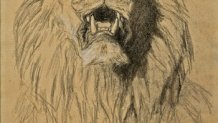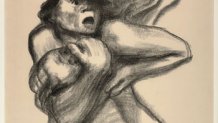With exhibitions like “Ida O’Keeffe: Escaping Georgia’s Shadow” and “Women + Design: New Works”, the Dallas Museum of Art (DMA) continues to celebrate women’s professional artistic careers with “Women Artists in Europe from the Monarchy to Modernism”, on view through June 9.
The timing of the exhibitions is a happy accident, with this newest exhibition conceived to serve as a complement to “Berthe Morisot, Woman Impressionist”, an upcoming exhibit opening February 24. The pocket-sized exhibition features significant works by female artists working in Europe from the 18th century to the early 20th century. Most of the works are from the DMA’s permanent collection.
Together, the works explore the restrictions women artists faced and dispel the notion that not many women were creating great art at that time.
“I think the long-held assumption is that women somehow didn’t possess the ability to make great art which is why we don’t see so many. But that is not really the case. The challenges that they faced were the lack of access to opportunity, to education, to training, to the most prestigious art institutions across Europe. It was almost insurmountable,” Nicole Myers, the Lillian and James H. Clark Curator of European Painting and Sculpture, said.
The first part of the exhibition lays out the traditional path men followed to become a respected artist and explains how women were deliberately excluded from that path. Few women were elected to powerful national art academies. Women could not attend classes featuring live nude models, were restricted from studying specific genres, and were pushed to into less prestigious artforms.
To overcome these obstacles, women needed two assets: money and a man. Supportive families paid for expensive private lessons. Male artists, relatives and teachers were essential advocates.
“Almost always when we know the names of successful women artists, even up to the 20th century, one of the key factors that unites them is their connection to an established male artist,” Myers said.
The Scene
Two women who were elected to the French Royal Academy of Painting and Sculpture on same in day in 1783 found different ways to navigate the obstacles of the art world. Élisabeth Louise Vigée-Le Brun was the daughter of a portraitist and gained the patronage of Marie Antoinette. Adélaïde Labille-Guiard studied under a family friend. Eventually, she married a successful artist who was a member of the Royal Academy.
At the time of their election, the Royal Academy had an unofficial cap of electing no more than four women. Le Brun and Labille-Guiard were the third and fourth women elected, and this development caused consternation among male artists. The Royal Academy sought a royal decree to enforce the cap.
“Just at this moment when you get these two fantastically talented women who are on the public stage, the door slams shut for younger women who wanted to follow in their path,” Myers said.

As the academies lost their power and art markets shifted their interest away from historic paintings, Rosa Bonheur became an unexpected celebrity. Her work featured animals. “She had a great empathy for her subjects,” Myers said. “She treats them as if they have personalities and souls.”
Her paintings were showcased on postcards and a Rosa Bonheur doll was distributed in the United States. “It wasn’t just the paintings that were enormously popular. It was actually her personality, which was larger-than-life and completely gender-bending, which is even more surprising that it was acceptable,” Myers said.
Bonheur used her work studying animals as justification for wearing pants in an era when women wore long skirts and petticoats. She cut her hair short, lived openly with a woman companion, smoked cigars and was outspoken about her opinions.

Kathë Kollwitz was the first women elected to the Prussian Academy in 1919. While studying in Berlin, she met her husband, a doctor. She often talked to her husband’s middle-class patients and used her art to draw attention to middle-class struggles.
“Some of the subjects near and dear to her heart were the emerging worker’s movement and the struggles that workers face, but also really tough emotional subject like poverty, the damage that war does, suffering, starvation and hunger and that will become more prominent after World War I,” Myers said.
To express social commentary, Kollwitz worked with printmaking, engraving and lithography. She spoke out against Nazism and was barred from exhibiting during World War II. Her Berlin apartment was bombed, destroying much of her work. She died weeks before the end of World War II.
Exhibiting these artists’ works and telling their stories continues one of the DMA’s traditions. “For me, it is a great honor to work at the DMA as they have historically prioritized collecting women artists,” Myers said. “It is something that is part of our fiber and history as an institution.”
MORE: DMA.org



